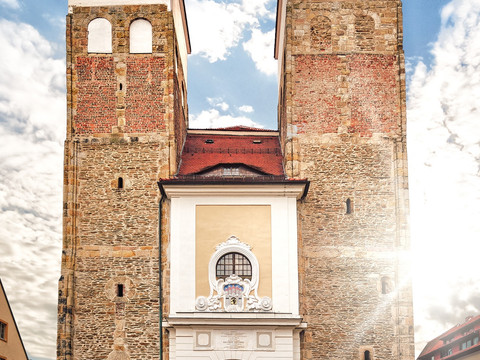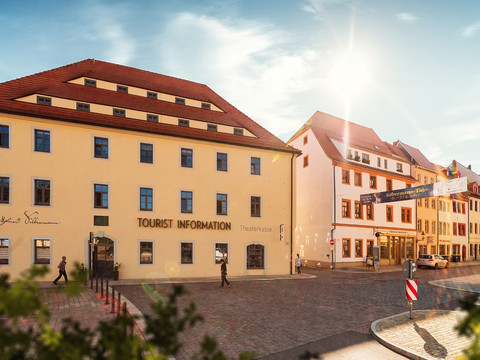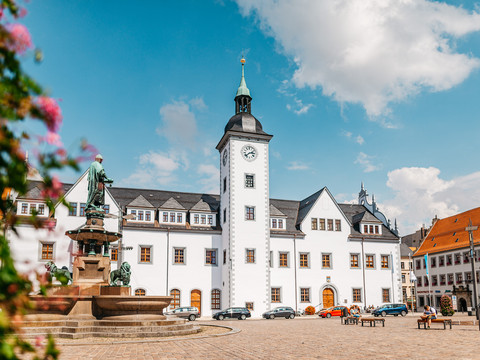Our tour begins at Untermarkt. Most of the buildings date back to the 16th century. St. Mary's Cathedral, famous for its Romanesque Golden Gate, the tulip pulpit and the Silbermann organs, is of course the dominant feature. The high Gothic building of the former cathedral courtyard, now the City & Mining Museum, is also striking. From Untermarkt, head towards Meißner Gasse. Just before Meißner Gasse, look down Bäckergässchen and at the end of the street you will see the "Dürer House" on Pfarrgasse from afar. The "Haus Dürer" was built on the lower Pfarrgasse between 1902 and 1903 and was the town's third secondary school. In 1928, the school was renamed "Dürerschule". During the war years 1941-1945, the house served as a military hospital. In 1963, it was divided into Oberschule "Albrecht Dürer" I and II. Since 1992, the building has belonged to the Geschwister-Scholl-Gymnasium and is part of the extended building complex consisting of the "Haus Albertinum" and "Haus Dürer" buildings.
Follow Meißner Gasse to the junction of Meißner Ring / Halsbrücker Straße. You are also on our new discovery trail. Kids can explore the history of the silver town and ore mining with interactive play elements. Tip: make sure you take a marble with you (or pick one up in advance for €2 at the tourist information office). Further information at www.freiberg.de/kultur-und-tourismus/sehenswertes/individiuelle-rundgaenge/entdecker-spur
Cross the traffic lights in the direction of Halsbrücker Straße and turn into Tuttendorfer Weg after approx. 130 m. Along the garden area there are numerous small and very small spoil tips and filled-in pits on the main gallery. Immediately behind the disused railroad line to the former northern thermal power station is the black pine-covered shaft dump of the Schöffauer Schacht on the right, to the left of the path there are further dumps on the Glückauf Spatgänge, which cross the main gallery here and have a direction between east/southeast and west/northwest. In the far background on the left is the shaft dump of the former Heilige Drei Könige mine (16th century) with its tall trees and the grave of Oberberghauptmann S. A. W. Freiherr v. Herder (1776-1838, son of the Weimar poet, godchild of Goethe).
From here, a detour to Herder's resting place is recommended. Behind this name is the neo-Gothic tomb of Freiberg's chief mining administrator Freiherr von Herder (1776 - 1838). The actual path, however, leads to the right to the "Reiche Zeche" mine. Follow the explorer's trail to the Reiche Zeche. In the late 19th century and throughout the 20th century, it was one of the most important mines of the "Himmelfahrt Fundgrube".
From the mine, a staircase takes you back to the Conradsdorfer Weg. Follow the path down into the valley.
To the right of the Conradsdorfer Weg is the "Hauptstollngang". This several-kilometre-long and up to seven-metre-thick (wide) ore vein was the most important in the Freiberg mining district and is said to have been discovered for the first time by chance in 1168 by salt hauliers who found silver-ore-bearing rocks in the tracks of their wagons.
On your way down into the valley, you cross the disused Freiberg - Halsbrücke railroad line, follow the road to the Mulde and keep left. After 100 m, you will come across two mouth holes shortly after each other. The one at the back is the mouth of the Alter Tiefen Fürstenstolln. The "Alte Fürstenstolln", which is located directly in the main gallery, has been documented since 1384 and is therefore the oldest.
Walk along the Roter Graben created in 1612/13. The yellow to reddish-brown color of the iron hydroxide precipitates, which gave the artificial trench its name, is striking. A large slag heap stands out on the right. It is the last witness to the Ludwigschacht, which was created in the mid-19th century by the Himmelfahrt Fundgrube. A little later, we come to the mouth of the Thurmhof auxiliary gallery. Nearby is the well-preserved hat house of the Verträglich Gesellschaft mine. After another 200 m, we reach the beginning of the "Roter Graben", which is fed here from the Verträgliche Gesellschaft Stolln with water from the main pits of the "Himmelfahrt Fundgrube".
Leave the Muldental and hike uphill to the ore railroad embankment. A few meters above is the mouth of the ore railway tunnel, which leads through the "Davidschacht" slag heap. After approx. 550 m, turn right just before the gardens onto the newly created path and you will come directly to Fuchsmühlenweg. You will recognize the winding tower of the "Reichen Zeche" in front of you. Follow Fuchsmühlenweg, past the central cemetery, for approx. 1 km until you reach the "Alte Elisabeth" slag heap. The people of Freiberg affectionately call the most famous mining monument in the silver town "Alte Elli". The mine was first mentioned in 1511 and the pit is still largely as it was when the last miners left it in 1913. Enjoy the view of the silver town from the pit. From the "Alte Elli" you return to Himmelfahrtsgasse. If you still have some time, you should definitely make a detour to the left to the Abrahamschacht. This site shows us a typical large ore mine from the 19th century which still used water power.
As mentioned, we return to the town via Himmelfahrtsgasse, past the Donat cemetery. Today's old Donat cemetery was established in 1531 and belonged to the Donat church, which was first mentioned in 1225. The wall is still visible today, with some of the arches and family crypts still intact. The old Donat cemetery contains almost 150 tombs, mostly made of sandstone. Representatives of the mining industry are buried here.
Cross the Donatsring (to be on the safe side, please stop at the traffic lights) and turn right past the Donatstor, through which the miners went to their shift. Right next to it is the 35 m high Donatsturm tower. The tower is part of the approximately 5 m high town wall. Walk along the city wall / park.
You will see the Freiberg district hospital on your right. In the entrance area of the Freiberg district hospital, a silver-colored steel cylinder marks a ventilation shaft through which almost germ-free mine air is taken from the old mine to air-condition the hospital.
Turn left into Terrassengasse and at the end of the street turn right into Pfarrgasse with its old houses, most of which date back to the 16th century, such as house no. 18, which belonged to the head miner Martin Planer (1510-1582), or no. 20, which belonged to the smelter official Paul Klotz.
Opposite this point, turn right downhill into Berggasse, where the first silver ore discovery (plaque on the house at Berggasse 1) was probably made in 1168 in the lower part of the main tunnel crossing here. To the left, the path leads uphill via Aschegasse to the Nikolaikirche church on Buttermarkt, the foundation stone of which was laid around 1180 and which is now used as a concert and conference hall. Opposite the church is the oldest municipal theater in the world (inaugurated in 1790), affectionately known as the "Semperoper".
Walk up Enge Gasse and turn left into the pedestrian street. Take a detour to the Obermarkt.
In the middle of the Obermarkt, the city founder "Otto the Rich" is enthroned on the Lion Fountain. Every day at 11.15 a.m. and 4.15 p.m., the Steigerlied can be heard from the tower of the town hall. From the oriel of the town hall, knight Kunz von Kauffungen looks down on his place of execution. Today's "Ratskeller" was built in 1545 as the town's department store.
From Obermarkt, return to Burgstraße and end your walk by strolling towards Schlossplatz. Freudenstein Castle is home to terra mineralia, probably the most beautiful and largest mineral exhibition in the world. At the Silbermann House, the path leads back to the starting point, Untermarkt, via Kirchgasse.













